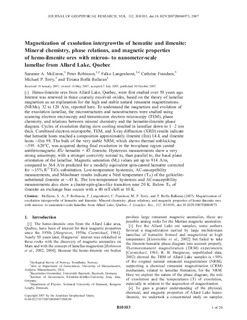| dc.description.abstract | [1] Hemo‐ilmenite ores from Allard Lake, Quebec, were first studied over 50 years ago. Interest was renewed in these coarsely exsolved oxides, based on the theory of lamellar magnetism as an explanation for the high and stable natural remanent magnetizations (NRMs), 32 to 120 A/m, reported here. To understand the magnetism and evolution of the exsolution lamellae, the microstructures and nanostructures were studied using scanning electron microscopy and transmission electron microscopy (TEM), phase chemistry, and relations between mineral chemistry and the hematite‐ilmenite phase diagram. Cycles of exsolution during slow cooling resulted in lamellae down to 1–2 nm thick. Combined electron microprobe, TEM, and X‐ray diffraction (XRD) results indicate that hematite hosts reached a composition approximately ilmenite (Ilm) 14.4, and ilmenite hosts ∼Ilm 98. The bulk of the very stable NRM, which shows thermal unblocking ∼595–620°C, was acquired during final exsolution in the two‐phase region canted antiferromagnetic Requation imagec hematite + Requation image ilmenite. Hysteresis measurements show a very strong anisotropy, with a stronger coercivity normal to, than parallel to, the basal plane orientation of the lamellae. Magnetic saturation (Ms) values are up to 914 A/m, compared to 564 A/m predicted for a modally equivalent spin‐canted hematite corrected for ∼15% R2+TiO3 substitution. Low‐temperature hysteresis, AC‐susceptibility measurements, and Mössbauer results indicate a Néel temperature (TN) of the geikielite‐substituted ilmenite at ∼43 K. The low‐temperature hysteresis and AC‐susceptibility measurements also show a cluster‐spin‐glass‐like transition near 20 K. Below TN of ilmenite an exchange bias occurs with a 40 mT shift at 10 K. | nb_NO |
